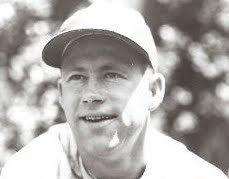 The Asheville Citizen-Times reported former Brooklyn Dodgers and Boston Braves outfielder Don Thompson passed away September 28, 2009 in Asheville, North Carolina after an extended illness. Thompson was originally signed by the Boston Red Sox as a pitcher in 1943, and pitched exclusively for four seasons until injuring his arm. During an April 2009 interview with Thompson, he recounted his transformation from a pitcher to an outfielder.
The Asheville Citizen-Times reported former Brooklyn Dodgers and Boston Braves outfielder Don Thompson passed away September 28, 2009 in Asheville, North Carolina after an extended illness. Thompson was originally signed by the Boston Red Sox as a pitcher in 1943, and pitched exclusively for four seasons until injuring his arm. During an April 2009 interview with Thompson, he recounted his transformation from a pitcher to an outfielder."I started out as a pitcher, but I hurt my arm," Thompson said. "I was in the Red Sox organization at that time with Louisville, and they sent me down to Roanoke. My arm got better but I stayed in the outfield. That’s when St. Louis drafted me (1948). I went to Columbus. I stayed as an outfielder. I didn’t have any desire to pitch."
Even though Thompson was a full-time outfielder, Brooklyn Dodger manager Charlie Dressen would often call on call on him when they were facing a tough lefty.
"Dressen, whenever we had a left handed pitcher pitching against us, he’d want me to throw batting practice to help the guys get ready. I still didn't want to pitch."
Once in the Cardinals organization, Thompson was immediately promoted to the AAA level, and sharpened his skills by playing two years of winter ball in Cuba under the watchful eye of Mike Gonzalez.
"The first year my manager was Mike Gonzalez," he said. "I played for Havana. Mike was an old catcher for St. Louis. I was playing in the International League with Rochester. After the 1949 season, he called me to come to Havana for the Winter. I went to Cuba, played for Havana the first year and then Almendares the second year. It helped me a great deal. I was already in shape going into Spring Training. It was sort of a circus down there. They really played hard and expected a lot out of the players."
Thompson's big break with the Dodgers came during the winter of 1949 when he was traded from the Boston Braves to the Dodgers for the legendary Sam Jethroe.
"I played against him in the International League. He was as fast as everyone said he was."
He entered a crowded Dodgers outfield, but managed to stick with the team for three seasons.
"We had seven left fielders in Brooklyn in Spring Training. I opened the season both years (1951 and 1953) in the starting lineup. I was a left-handed hitter, and Dressen, he was playing right-handed hitters against left-handed pitchers and switching things around. He had a platoon going. I wasn’t much of a hitter, but I was a very good fielder and I had good speed."
His defense played a memorable role in the 1953 World Series when he threw out Billy Martin at the plate in Game 4 after replacing Jackie Robinson in left field. During the aforementioned interview, Thompson clearly recounted how the inning unfolded.
"Clem Labine was pitching, he came in for relief. Martin was on second base with two outs. Mantle hit a line drive over Pee Wee’s head. He was hitting left-handed, so I was playing him a little around towards right. He hit the line drive and of course Martin took off, there being two outs. Anyway, I saw Martin running, [3rd base coach] Frankie Crosetti was waving him home. I looked up and I turned it loose. Billy Cox let it go or it would have hit him right in the head. It was about that high. Campy had him by several feet. Martin bent over and tried to knock Campy down. Campy sidestepped him with the ball in his mitt, hit him under the neck and turned him a flip. That was the last out of the game. I replaced Jackie Robinson both games. He could handle the outfield pretty well, but he wasn’t used to it."
Thompson retired after the 1954 season, but it wasn't before he had another brush with greatness. During most of the 1954 campaign, he played with Montreal. Under his wing was a 19-year-old outfielder from Puerto Rico by the name of Roberto Clemente. Thompson knew that the Dodgers had a gem on their hands as soon as Clemente hit the field.
"He worked out with me in center field to start," he said. "He had a great arm and he could hit; he hit a lot of bad pitches, like Berra, over his head. He was a wild swinger, but I could tell he was going to be a good ballplayer. I think he got a bonus of $25,000 from the Dodgers. They were trying to hide him. He was eligible for the big league draft. They knew that if they didn’t take him on Brooklyn that he would possibly be drafted. I knew he was going to be great. Roberto had a temper at times, but got along with us well."
After the 1954 season, Thompson returned to Asheville and effectively retired from baseball.
"I had an older brother in Asheville who had a Dodge / Plymouth franchise and I went into the automobile business. I stopped playing baseball completely after that."
He later became a real estate agent and one of the founders of Preferred Properties in Asheville. He was inducted into the Brooklyn Dodgers Hall of Fame in 1997.
 |
| Don Thompson avoiding the tag of Ted Kluszewski |
